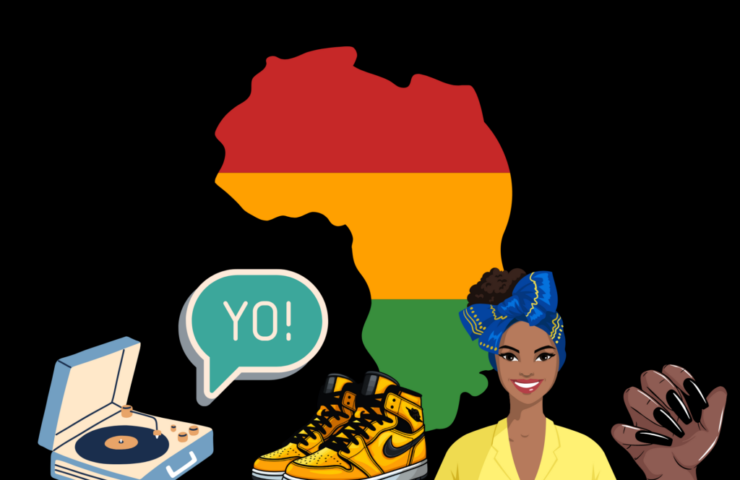February marks the start of one of the most impactful calendar months: Black History Month. Let’s take a closer look into the history of Black creations, trends and more!
Gadgets
Home Security System
Marie Van Brittan Brown, with the help of her husband Albert Brown, found a creative way to feel safe in 1966. The Browns lived in Jamaica, Queens, New York, and would work irregularly. The lack of police response to crime in the neighborhood inspired Marie and Albert to create the first security system.
The system consisted of a camera, TV monitors to mirror images, microphones and four peepholes. By receiving a patent in 1969, the security system has evolved to continue protecting Americans producing other systems such as Ring and ADT.
Turntable Slip Mat
DJ Grandmaster Flash started scratching and mixing records on turntables in the ’70s to create new sounds, prompting him to be one of the first Black people to use a turntable as an instrument.
While doing this, Flash realized something needed to be placed under the discs to prevent sliding and improve sounds. Flash created the slip mat with fabrics his seamstress mother had around.
Slip mat options range from rubber, cork, felt and leather. Each material can alter the sound of vinyl, so it’s best to use personal judgment on vinyl owned and turntable to determine which is best.
Fashion
Nails
Black Americans adopted acrylic and painted nails around 1950 after acrylics were created by Fred Slack, a dentist who wanted protection from chipped nails in the office.
In 1966, Donyale Luna displayed her nails as the first Black American woman to be on the cover of Vogue. The nails showcased the creativity of art display and even wealthiness of a person. The creative look had popular artists such as Janet Jackson, Donna Summer and Diana Ross rocking colorful sets.
The growth of designs and lengths of nails have grown over time, gaining more traction in the ’90s and 2000s when rappers such as Missy Elliot sported these designs.
Hair Positivity
Black Americans have made sure to allow their hair to represent their cultural and diverse backgrounds, despite long restricted history.
One of the first documents of hair restrictions was in the late 1700s when Tignon’s law was established by Governor Esteban Rodriguez. It prohibited Creole women from displaying their hair in New Orleans, requiring women to wrap their hair in a tignon, hiding it and representing they were slaves, whether they were one or not. The law diminished due to Creole women rebelling.
However, Black people still faced backlash for their hair, such as being discriminated against in the workplace and rejection from jobs.
It wasn’t until 2019, that a law called The CROWN Act was set in place in California to prohibit this. The act has been enacted in 23 states as of now, including Texas.
Baggy and Oversized Clothing
Streetwear has been a trendy style ever since the ’70s. But did you know Black Americans started the influence?
The popularization of streetwear styles emerged from hip-hop artists in the ’80s. Artists wore baggy and oversized clothes due to clothes being hand-me-downs and not fitting.
The style gained traction in the ’90s, with Aaliyah, Destiny’s Child and Tupac showing off their colorful looks. The style was worn for trend, to resonate with their fans and to show normality.
Streetwear fashion has also been spotted in popular media such as Fresh Prince of Bel-Air, Kenan & Kel, Boyz in the Hood and Love and Basketball.
Sneaker Culture
Shoes can be something that identifies a person off the bat. Most believe shoes are what truly pull an outfit all together, and will look at one’s feet before initiating conversation.
Back in the ’80s and ’90s when streetwear was evolving, so was sneaker culture. The love for sneakers furthered when Michael Jordan signed a deal with Nike in 1984, creating the first pair of Air Jordans.
With Jordan being a star player, Black American celebrities wearing Jordans and other stylish kicks to portray “shoe game” in the media. Sneaker culture took off and created a new passion for collectors, average-goers and resale stores.
Dances
Dancing in Black and African culture has been an important staple for thousands of years. There are numerous styles and techniques that require talent or can be learned quickly.
The art of dance served as a way to represent music and theatre. Dances usually have a main purpose and depend on settings. For example, dancing can be used in religious or spiritual ceremonies, representing power. Dancing can also be seen at anniversaries and funerals, to showcase life.
Impactful dances in Black American and African cultures include The Charleston, breakdancing and line dancing. Dance culture can also represent cities. Notable origins of dances include the Southside from Houston, Sharp Bounce from New Jersey and “getting sturdy” from NYC.
Slang
African American Vernacular English, also known as Ebonics, serves “to highlight the African roots of African American speech.”
Unfortunately, the language of AAVE can be misinterpreted as “Gen Z” language. This can be seen as offensive in the Black community, by erasing the influence African Americans have in the language we speak today.
African Americans have popularized slang terms that may have been previously used and gained traction years later or immediately became popular.
“Bae“
The word “bae” has been adopted by Black Americans to serve as a term of endearment, mostly in relationships. The term gained popularity for different meanings in the 21st century. Confusion arose on what the real origin of the word means.
One origin of the word, notes that it’s an acronym for “Before Anyone Else,” and another states it’s short for baby. However, all origins can go hand in hand with representing someone you love, or even one of your close friends.
“It’s Giving” and “Serve”
This term originated from African American ballroom scenes; these scenes and competitions started in New York in the 1980s and have numerous categories dancers participate in.
The terms in ballroom has been used interchangeably as compliments, showing that one has excelled in their category. For example, if someone said “It’s giving” or “serving face” it would mean one’s face is stunning.
The terms gained popularity on TikTok in 2022 and are still used today. They can be used to describe people’s style, vibes or energy.
“Spill the Tea“
The word “tea” became a polysemy when drag queen Lady Chablis introduced the term as just “T.”
In an interview for the book “Midnight in the Garden of Good and Evil,” Chablis was interviewed and used “T” for the first time. “Yeah, my T. My thing, my business, what’s going on in my life,” she stated.
While Chablis used the term to mean “truth,” it can still mean that, but it’s been commonly expanded to “tea” meaning “gossip,” or exclusive information. By spilling the “tea,” it’s used when juicy information can be revealed. The term can also be related to spilling the beans.





Recent Comments